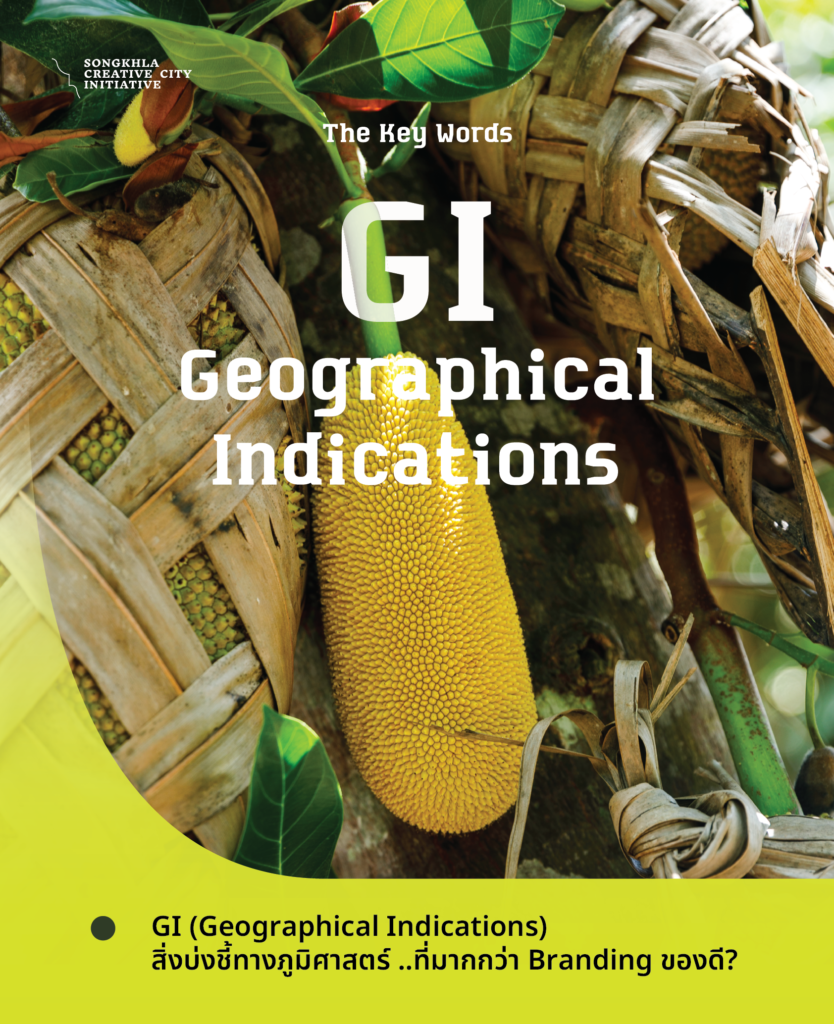More than just good branding?
“This is an outstanding thing from the province. I’ve grown this fruit before. This menu must come from this community, it’s authentic”

We have probably heard this type of conversation many times when discussing specialty, identity, and “outstanding” local produce and products, but the meaning is deeper than simply catchy, easy-to-say branding to promote sales and purchases.
The question is, who defines “outstanding”, and what makes something outstanding?
The Key Words จึงอยากชวนทุกท่านย้อนกับไปทำความรู้จัก ‘GI (Geographical Indications) สิ่งบ่งชี้ทางภูมิศาสตร์’ ที่หน่วยงานทั้งรัฐและเอกชนนิยามใช้นำมาอ้างอิงกำกับความเป็น ‘ของดี’ ที่คนไทยคุ้นหู และยอมรับ พร้อมกับอยากชวนคิดต่อถึงเป้าหมายของการเป็น ‘ของดี’ และเป็นของดีแล้วจะอย่างไร? ไปไหน? หรืออีกเป้าหมายแท้ของการบอกว่าเป็น ‘ของดี’ คือการบอกใบ้ว่าเราควรดูแล ‘ของดี’ นั้นอย่างไร?
GI (Geographical Indications)
The concept of GI was first developed at the Paris Convention for the Protection of Industrial Property, signed by numerous countries in Paris, France, on 20th March 1883. Initially, the convention used indications of sources and appellations of origin as primary issues to consider when discussing the protection of industrial property. Subsequently, the definition was expanded and clearly defined within GI: Geographical Indications in the Lisbon Agreement in 1958 and Trade-Related Aspects of Intellectual Property (TRIPS) Agreement, stipulating that WTO member standards prioritize protection of GI products.
Thailand joined the World Intellectual Property Organization (WIPO) in 1989, an international organization under the United Nations, responsible for international agreements pertaining to intellectual property issues, such as patents, trademarks, copyrights, industrial designs, and GIs (Geographical Indications).
Decades later, the concept of GI was introduced into our national legislation via 4 main laws: Criminal Code Section 271, Consumer Protection Act BE 2522 amended BE 2541 in Section 21, Trademark Law – Trademark Act BE 2534 amended BE 2543, and the Geographical Indication Protection Act BE 2546.
The last stated Act defines “Geographical Indication” as “a name, symbol or other object used to refer to or represent a geographical origin, indicating that goods from that geographical origin possess the quality, reputation or characteristics specific to that geographical origin”.
___
Having read this far, many people may be wondering where the marketing value and branding of GI in our country comes from. This first issue concerns the ‘definition of locality’, that we often raise as the storytelling behind outstanding products. In terms of marketing, GI is not easy to obtain, and must be registered with the government via a registration request with the Department of Intellectual Property, with stages of careful consideration and verification of documents. Once registered, GI status can be utilized. However, it is limited to local producers and traders related to that product. To be used by anyone else is a criminal offence. For example, salted eggs produced in Bangkok cannot be advertised with the words “Chaiya salted eggs” or even “Chaiya salted eggs recipe”. Advertising as such to mislead customers is considered a crime.
___
Registration of GI produce and products thus includes both dimensions of local value and legal protection. The main idea is to maintain the value of identity as connected to locality, protect entrepreneurs and related communities, and protect such assets so as to maintain their value.
Apart from asking which ‘outstanding things in our country’ should be identified for registration, and it is not certain that all items intended to be presented will be registered, an interesting question for further consideration is how to make local areas, private sectors, and local people helping to promote outstanding things more prominent to both outsiders and insiders, and how to pass on this knowledge from generation to generation, in order to make GI about more than simply branding and reputation, but a developmental milestone in which all parties participate and achieve collaboratively.